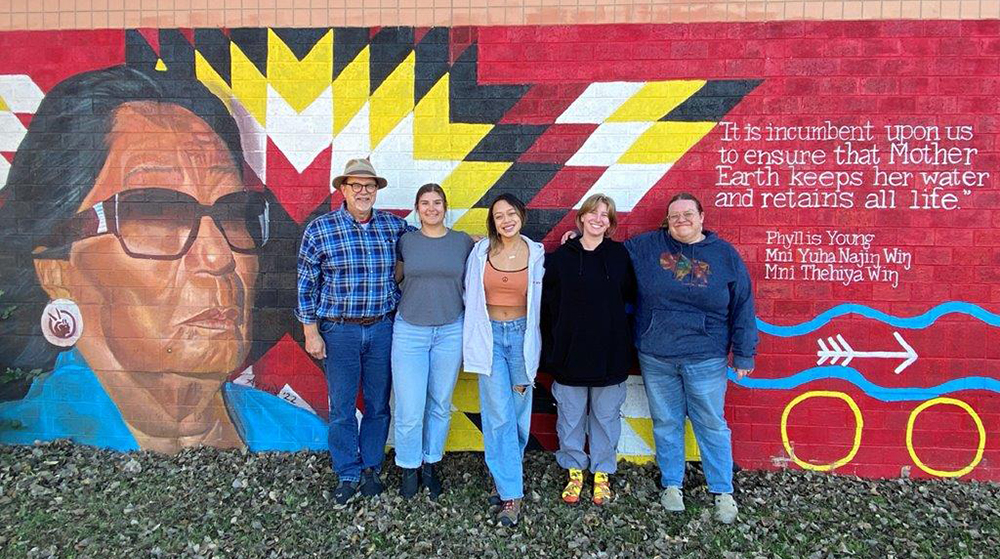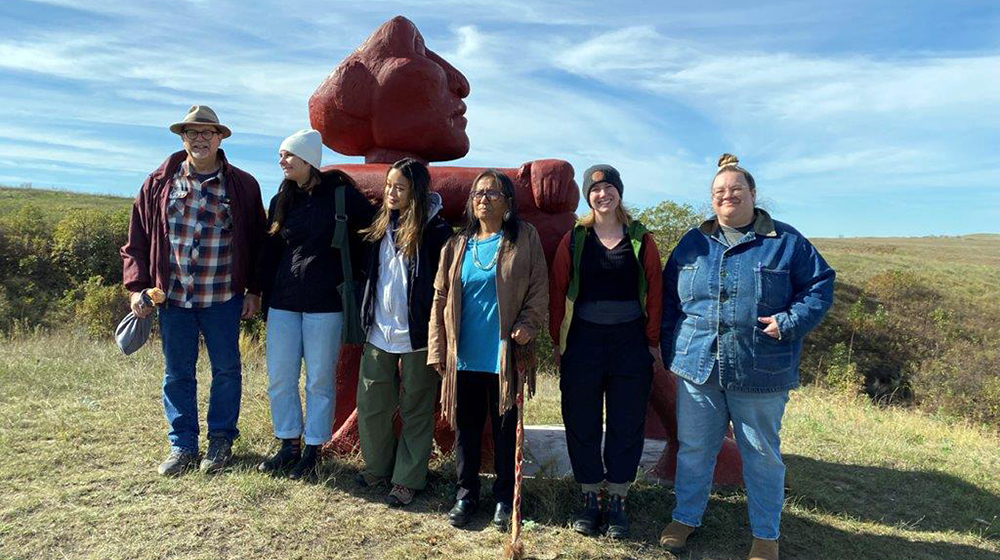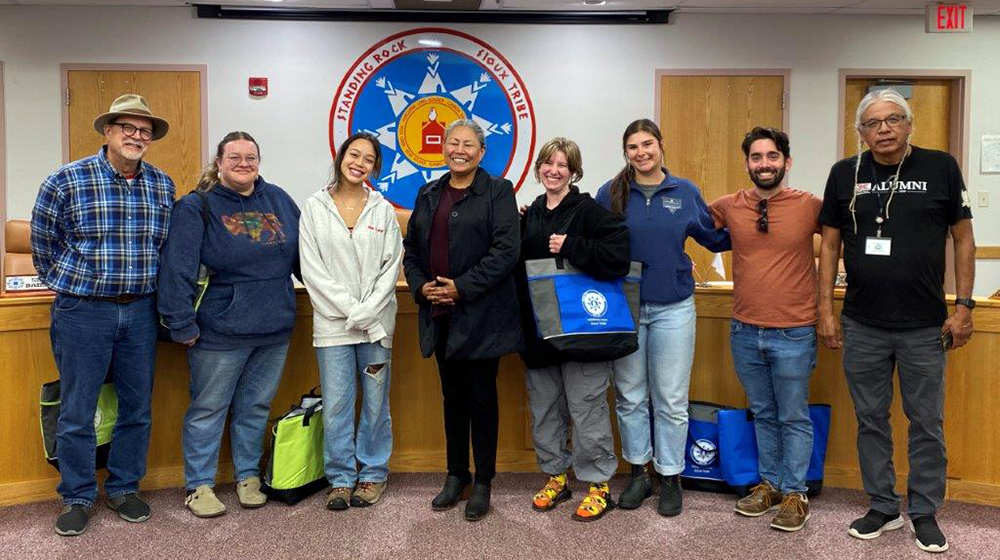Standing Rock Trip
Loyola Students Visit the Standing Rock Sioux Reservation
In October 2023, a group of Loyola students led by Michael Schuck, PhD, embarked on a pilgrimage to the Standing Rock Sioux Reservation. The purpose of the trip was to foster a deeper connection with the Lakota People who call Standing Rock home and build allyship through direct communication and shared experiences. The trip allowed students to learn firsthand about the indigenous nations’ continuous struggle with the Dakota Access Pipeline (DAPL).

Students met with tribal leaders including Phyllis Young, who is depicted in a mural honoring her leadership in the fight against the DAPL.
The Dakota Access Pipeline (DAPL) is a 1,172-mile-long underground pipeline that transports crude oil from northwestern North Dakota through South Dakota and Iowa to a pipeline hub in southern Illinois. Since its announcement in 2014, the project has faced strong resistance from the Standing Rock Sioux Tribe and its allies. The opposition stems from concerns about potential environmental harm, the desecration of sacred sites, violations of treaty rights, and the risk of contaminating the tribe’s primary water source, the Missouri River.
The global #NoDAPL movement gained momentum as diverse groups, including non-indigenous communities and environmentalists, joined forces with the Lakota People and other Native American tribes to protest the pipeline’s construction. Starting in 2016, thousands of protesters gathered and formed encampments near pipeline construction sites to express their opposition. In February 2017, police and private security forces dispersed the protesters using riot gear and military equipment. Construction proceeded, and the pipeline became operational later that year. For the Standing Rock Sioux Tribe, however, the fight is not over. A coalition of Lakota tribes across North and South Dakota and beyond continue to voice opposition to the pipeline and call for shutting it down.
The Loyola group set out to better understand the Lakota People’s ongoing struggles and learn from those involved in the historic actions for environmental justice. Participants included students Erica Chelmowski, Julien Sieber, Fiona Farrer, Madison Mede, and Tori Wright, with majors ranging from environmental science to anthropology. During the trip, the students engaged in a busy schedule of meetings, discussions, and immersive experiences that went beyond sightseeing to foster genuine connections with the community.
The journey began on a Thursday evening as the group departed from Loyola University Chicago. They stopped overnight in Maple Grove, Minnesota, before traveling to the Standing Rock Reservation, which straddles the borders of North and South Dakota.
Friday saw the group meeting with Tomi Phillips, PhD, president of Sitting Bull College, and Daniel Paul Nelson and Phyllis Young from the Lakota People’s Law Project. The meetings provided a unique opportunity for the students to learn about the complexities surrounding environmental issues, indigenous rights, and how the local tribal college is addressing these issues. A subsequent dinner meeting with Nelson and Young allowed for a more informal exchange of ideas, fostering trust and friendship within the group.

The students viewed the Not Afraid to Look sculpture, which is all that remains of the Sacred Stone Encampment where DAPL protesters had gathered.
Saturday unfolded as a day dedicated to cultural immersion and dialogue. The group spent time with tribal leaders Phyllis Young and Valerie Antelope, gaining insights into the historic #NoDAPL camps where tribal members and their supporters had gathered to protest the pipeline.
Students also visited significant sites like the Not Afraid to Look sculpture by artist Charles Rencountre of the Lower Brule Sioux Nation. The eight-foot-high statue of a seated figure overlooks the location of the Sacred Stone Encampment, and it is all that remains of the camp.
Sunday was a day of spiritual and historical exploration, starting with a Roman Catholic Mass at St. Peter’s Catholic Church, led by Monsignor Chad Gion. The ensuing discussions delved into the history of the Roman Catholic Indian Mission and the present challenges faced by St. Bernard’s Mission School. The group then went on to Sitting Bull’s last camp community site on a remote section of the Grand River. An old Sundance Ceremony structure was there, which led to an important discussion of traditional Lakota spiritual practices. Trip participant Tori Wright stated that this encounter provided a crucial historical context to the ongoing struggles of the Lakota People.
Later that evening, the group participated in an Inipi (sweat lodge) Ceremony led by Hoksila White Mountain at the Iyuha Acu Youth Services Center. Tori Wright described the moment as a “profound spiritual experience” that deepened the students’ connection with the Lakota traditions.

The Loyola group met with leaders including Standing Rock Tribal Chairwoman Janet Alkire (center) and Tim Mintz, former tribal historic preservation officer for the Standing Rock Sioux Tribe (right).
On Monday, the group visited the Standing Rock Sioux Tribal Headquarters Building. They met with tribal leaders, including Doug Crow Ghost, Tim Mintz, John Pretty Bear, Kerry Libby, and Standing Rock Tribal Chairwoman Janet Alkire. Discussions spanned topics from water resources to historic preservation, offering the students a comprehensive understanding of the complex issues faced by the tribe. Tori Wright emphasized the significance of these conversations, stating that they provided a multifaceted perspective on the community’s ongoing struggles.
The journey ended on Tuesday morning as the group departed for Chicago, carrying with them many profound experiences and a newfound understanding of the struggles and resilience of the Standing Rock Sioux Tribe.
As the group returns to their daily lives, they fervently encourage support for the Standing Rock Tribe’s ongoing fight against the Dakota Access Pipeline. The draft Environmental Impact Statement (EIS) for DAPL is under public review, and they urge the public to submit comments demanding the removal of the pipeline. The efforts to organize against the pipeline offer an inspiring example of people coming together to advance environmental justice, and every act of support counts in the ongoing struggle.
-- Story by Jorge Haddad
-- Photos provided by student trip participants
The Dakota Access Pipeline (DAPL) is a 1,172-mile-long underground pipeline that transports crude oil from northwestern North Dakota through South Dakota and Iowa to a pipeline hub in southern Illinois. Since its announcement in 2014, the project has faced strong resistance from the Standing Rock Sioux Tribe and its allies. The opposition stems from concerns about potential environmental harm, the desecration of sacred sites, violations of treaty rights, and the risk of contaminating the tribe’s primary water source, the Missouri River.
The global #NoDAPL movement gained momentum as diverse groups, including non-indigenous communities and environmentalists, joined forces with the Lakota People and other Native American tribes to protest the pipeline’s construction. Starting in 2016, thousands of protesters gathered and formed encampments near pipeline construction sites to express their opposition. In February 2017, police and private security forces dispersed the protesters using riot gear and military equipment. Construction proceeded, and the pipeline became operational later that year. For the Standing Rock Sioux Tribe, however, the fight is not over. A coalition of Lakota tribes across North and South Dakota and beyond continue to voice opposition to the pipeline and call for shutting it down.
The Loyola group set out to better understand the Lakota People’s ongoing struggles and learn from those involved in the historic actions for environmental justice. Participants included students Erica Chelmowski, Julien Sieber, Fiona Farrer, Madison Mede, and Tori Wright, with majors ranging from environmental science to anthropology. During the trip, the students engaged in a busy schedule of meetings, discussions, and immersive experiences that went beyond sightseeing to foster genuine connections with the community.
The journey began on a Thursday evening as the group departed from Loyola University Chicago. They stopped overnight in Maple Grove, Minnesota, before traveling to the Standing Rock Reservation, which straddles the borders of North and South Dakota.
Friday saw the group meeting with Tomi Phillips, PhD, president of Sitting Bull College, and Daniel Paul Nelson and Phyllis Young from the Lakota People’s Law Project. The meetings provided a unique opportunity for the students to learn about the complexities surrounding environmental issues, indigenous rights, and how the local tribal college is addressing these issues. A subsequent dinner meeting with Nelson and Young allowed for a more informal exchange of ideas, fostering trust and friendship within the group.
Saturday unfolded as a day dedicated to cultural immersion and dialogue. The group spent time with tribal leaders Phyllis Young and Valerie Antelope, gaining insights into the historic #NoDAPL camps where tribal members and their supporters had gathered to protest the pipeline.
Students also visited significant sites like the Not Afraid to Look sculpture by artist Charles Rencountre of the Lower Brule Sioux Nation. The eight-foot-high statue of a seated figure overlooks the location of the Sacred Stone Encampment, and it is all that remains of the camp.
Sunday was a day of spiritual and historical exploration, starting with a Roman Catholic Mass at St. Peter’s Catholic Church, led by Monsignor Chad Gion. The ensuing discussions delved into the history of the Roman Catholic Indian Mission and the present challenges faced by St. Bernard’s Mission School. The group then went on to Sitting Bull’s last camp community site on a remote section of the Grand River. An old Sundance Ceremony structure was there, which led to an important discussion of traditional Lakota spiritual practices. Trip participant Tori Wright stated that this encounter provided a crucial historical context to the ongoing struggles of the Lakota People.
Later that evening, the group participated in an Inipi (sweat lodge) Ceremony led by Hoksila White Mountain at the Iyuha Acu Youth Services Center. Tori Wright described the moment as a “profound spiritual experience” that deepened the students’ connection with the Lakota traditions.
On Monday, the group visited the Standing Rock Sioux Tribal Headquarters Building. They met with tribal leaders, including Doug Crow Ghost, Tim Mintz, John Pretty Bear, Kerry Libby, and Standing Rock Tribal Chairwoman Janet Alkire. Discussions spanned topics from water resources to historic preservation, offering the students a comprehensive understanding of the complex issues faced by the tribe. Tori Wright emphasized the significance of these conversations, stating that they provided a multifaceted perspective on the community’s ongoing struggles.
The journey ended on Tuesday morning as the group departed for Chicago, carrying with them many profound experiences and a newfound understanding of the struggles and resilience of the Standing Rock Sioux Tribe.
As the group returns to their daily lives, they fervently encourage support for the Standing Rock Tribe’s ongoing fight against the Dakota Access Pipeline. The draft Environmental Impact Statement (EIS) for DAPL is under public review, and they urge the public to submit comments demanding the removal of the pipeline. The efforts to organize against the pipeline offer an inspiring example of people coming together to advance environmental justice, and every act of support counts in the ongoing struggle.
-- Story by Jorge Haddad
-- Photos provided by student trip participants
